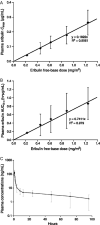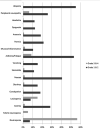Eribulin -- a review of preclinical and clinical studies
- PMID: 21493087
- PMCID: PMC3954568
- DOI: 10.1016/j.critrevonc.2011.03.002
Eribulin -- a review of preclinical and clinical studies
Abstract
Eribulin mesylate is a non-taxane, structurally simplified, completely synthetic, halichondrin B derivative with an end poisoning, microtubule inhibitory action. Preclinical studies have demonstrated activity in various cancer cell lines and synergistic action with gemcitabine, epirubicin, trastuzumab, cisplatin, docetaxel and vinorelbine. Eribulin has recently been approved by United States Food and Drug Administration as a third line therapy for metastatic breast cancer patients, who have previously been treated with an anthracycline and a taxane. It has also advanced to phase II trials in non-small cell lung cancer, pancreatic, prostate, bladder, head and neck cancers, sarcomas and ovarian and other gynecological tumors. Combination trials with carboplatin, gemcitabine, pemetrexed, cisplatin, and erlotinib are currently ongoing. Eribulin potentially has a low incidence of peripheral neuropathy. The predominant side effects are neutropenia and fatigue, which are manageable. This article reviews the available information on eribulin with respect to its clinical pharmacology, mechanism of action, pharmacokinetics, pharmacodynamics, metabolism, preclinical studies and clinical trials.
© 2011 Elsevier Ireland Ltd. All rights reserved.
Figures





Similar articles
-
Eribulin in Cancer Treatment.Mar Drugs. 2015 Aug 7;13(8):5016-58. doi: 10.3390/md13085016. Mar Drugs. 2015. PMID: 26262627 Free PMC article. Review.
-
Eribulin mesylate (E7389): review of efficacy and tolerability in breast, pancreatic, head and neck, and non-small cell lung cancer.Clin Ther. 2012 Jul;34(7):1467-73. doi: 10.1016/j.clinthera.2012.06.003. Epub 2012 Jun 25. Clin Ther. 2012. PMID: 22739019 Review.
-
Eribulin mesilate, a halichondrin B analogue, in the treatment of breast cancer.Drugs Today (Barc). 2010 Sep;46(9):641-53. doi: 10.1358/dot.2010.46.9.1519020. Drugs Today (Barc). 2010. PMID: 20967296
-
Eribulin mesylate.Clin Cancer Res. 2011 Nov 1;17(21):6615-22. doi: 10.1158/1078-0432.CCR-11-1807. Epub 2011 Aug 22. Clin Cancer Res. 2011. PMID: 21859830 Review.
-
Effectiveness and safety of eribulin mesylate: a new therapeutic option in the treatment of metastatic breast cancer.Expert Opin Drug Saf. 2012 Jul;11(4):643-50. doi: 10.1517/14740338.2012.698608. Epub 2012 Jun 14. Expert Opin Drug Saf. 2012. PMID: 22694309
Cited by
-
Liposome-Encapsulated Eribulin Shows Enhanced Antitumor Activity over Eribulin for Combination Therapy with Anti-PD-1 Antibody.Mol Cancer Ther. 2023 Apr 3;22(4):499-510. doi: 10.1158/1535-7163.MCT-22-0475. Mol Cancer Ther. 2023. PMID: 36696578 Free PMC article.
-
Combination of Abemaciclib following Eribulin Overcomes Palbociclib-Resistant Breast Cancer by Inhibiting the G2/M Cell Cycle Phase.Cancers (Basel). 2022 Jan 1;14(1):210. doi: 10.3390/cancers14010210. Cancers (Basel). 2022. PMID: 35008374 Free PMC article.
-
Neurymenolide A, a Novel Mitotic Spindle Poison from the New Caledonian Rhodophyta Phacelocarpus neurymenioides.Mar Drugs. 2019 Feb 1;17(2):93. doi: 10.3390/md17020093. Mar Drugs. 2019. PMID: 30717235 Free PMC article.
-
Recent Advances in the Development of Antineoplastic Agents Derived from Natural Products.Drugs. 2015 Nov;75(17):1993-2016. doi: 10.1007/s40265-015-0489-4. Drugs. 2015. PMID: 26501980 Free PMC article. Review.
-
Neuropathy-inducing effects of eribulin mesylate versus paclitaxel in mice with preexisting neuropathy.Neurotox Res. 2013 Oct;24(3):338-44. doi: 10.1007/s12640-013-9394-3. Epub 2013 Apr 30. Neurotox Res. 2013. PMID: 23637052 Free PMC article.
References
-
- Uemura D, Takahashi K, Yamamoto T, et al. Norhalichondrin A: an antitumor polyether macrolide from a marine sponge. J Am Chem Soc. 1985;107(16):4796–8.
-
- Hirata Y, Uemura D. Halichondrins—antitumor polyether macrolides from a marine sponge. Pure Appl Chem. 1986;58(5):701–10.
-
- Pettit GR, Herald CL, Boyd MR, et al. Isolation and structure of the cell growth inhibitory constituents from the western Pacific marine sponge Axinella sp. J Med Chem. 1991;34(11):3339–40. - PubMed
-
- Pettit GR, Tan R, Gao F, et al. Isolation and structure of halistatin 1 from the eastern Indian Ocean marine sponge Phakellia carteri. J Org Chem. 1993;58(9):2538–43.
-
- Gravelos DG, Lake R, Blunt JW, Munro MHG, Litaudon MSP. Halichondrins: cytotoxic polyether macrolides. European Patent Office; Munich, Switzerland: 1993. Publication number EP 0 572 109 A1.
Publication types
MeSH terms
Substances
Grants and funding
LinkOut - more resources
Full Text Sources
Other Literature Sources
Medical

